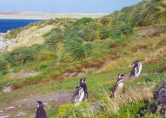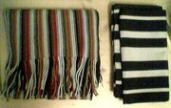Falkland Islands
South Atlantic OceanLevel of surfing
Evolved
Quality of surf
Average
Call code
500
Net code
fk
Area
12173
Coastline
1,288 km
Climate
Cold Marine
Hazards
Very Isolated, Extreme Cold, Severe Storms, Difficult Access
Best Months
October - December
Population
3060
Currency
Falkland Pound (FKP) Pegged to the UK Pound Stirling
Time Zone
QUEBEC (UTC-4) to DST PAPA (UTC-3)
Special Requirements
Limited Surfing Supplies Available
surfing

Apcbg: Gypsy Cove, Falkland Islands; 2006
This part of the world is where Pacific swell is born, as a result, you are often too close to the genesis area of these storms, fronts and depressions to enjoy clean swell. Summer is your only season here (Dec-Feb). The nearby horn of South America to the south west blocks many significant systems, leaving only the deep summer low travelling systems to the south as your prime energy source. The deciding factor is the temperature, even with the latest technology available, human life is basically unsustainable in these waters for any real period of time. You will need titanium vests, drysuts, experimental heating systems and thats just to start. Most surfers use a board with a 'diamond deck', so inbuilt onboard texture on the deck, similar to what is used in the windsurfing industry. The type of wax you would need to be effective here would be liquid at normal room temperature and so transport of it to and from the break once on your board is difficult.
Winter is dark virtually all year round and ice is a big problem, apart from the reality of hitting something it effectively attenuates any swell in the area. The months either side are really pushing the limits of human endurance but with a few hours of sunlight on average it is a possibility for the well prepared. Swells here are massive but often a near blizzard of wind and spray. Summer will bring respite as the storm cells retreat just a little further south.
Hypothermia is a real problem here and drysuits can be difficult to manouvre in. The most exciting aspect of surfing here is that it is truly pushing the boundaries of what surfing is. For once, technology is being dragged kicking and screaming behind some of the expeditions to areas such as this, any day now it is going to catch up and when that happens, extreme cold water surfing will eventially become a mainstream activity. Waves in areas such as this will be the new discoveries and uncrowded paradises of the next generation of surfers. Trade in your boardies for a 7mm steamer, booties and hood and get onboard!
what to pack

Pupils info: Some folded scarves, 20 December 2005
Strong westerly winds are a constant in many parts of the islands, temperatures are cool, and snow may occur at any time except for January and February, although accumulation is rare. So a sturdy rucksack, with emergency supplies is an excellent idea. You never know what the weather might bring, even if it's sunny when you start out.
Warm clothes and camping gear for the cold weather. There are hospitals in Stanley, but if you want to stay outside of the capital, bring your own medicines.
Sunscreen is an absolute must. There is the Antarctic ozone hole above the Falklands, so it is important to wear sunscreen on sunny days during the early summer.
You will need a good camera to shoot the wildlife from the distance (coming closer may very dangerous and it's no good disturbing animals).






